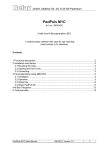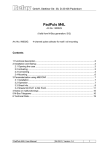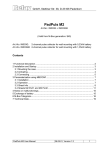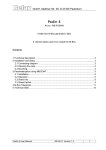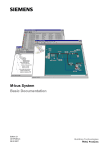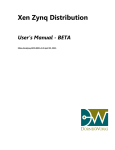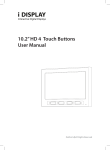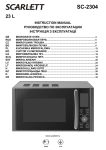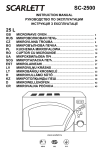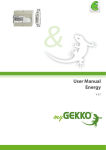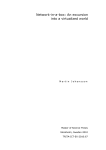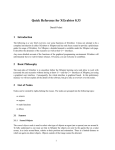Download PadPuls M1 - PadMess GmbH
Transcript
GmbH, Stettiner Str. 38, D-33106 Paderborn PadPuls M1 Art. no.: IM001 + IM001G (Valid from M-Bus generation: $07) Article no. IM001: Article no. IM001G: 1-channel pulse collector (OEM board) 1-channel pulse collector with case for wall-mounting Contents 1 Functional description .................................................................................................. 2 2 Installation and startup ................................................................................................. 3 2.1 Mounting the case ................................................................................................. 3 2.2 Opening the case .................................................................................................. 3 2.3 Connecting ............................................................................................................ 3 3 Parameterization using MBCONF................................................................................ 5 3.1 Installation ............................................................................................................. 5 3.2 Operation............................................................................................................... 5 3.3 Sheet Info .............................................................................................................. 6 3.3 Sheet PadPuls M1................................................................................................. 9 4 M-Bus Telegrams....................................................................................................... 12 5 Technical data............................................................................................................ 14 PadPuls M1 User Manual 26.09.01, Version 1.3 1 GmbH, Stettiner Str. 38, D-33106 Paderborn 1 Functional description The PadPuls M1 serves for the adaptation to the M-bus system of consumption measuring instruments, such as, current, gas or water meters. However, the meters to be adapted must have a floating pulse output. The user can configure the PadPuls M1 with the MBCOPNF program so that the scanned impulses are converted to units such as kWh, m3, J and so on. The configuration is very easy with the MBCONF user interface. When connected to the M-bus the PadPuls M1 is powered from the bus. A built-in battery ensures that metering continues even if the M-Bus fails for longer than the normal calibration time for the water meter or heat counter. The battery also ensures that the meter readings and the configuration data is maintained in RAM. The battery jumper should therefore be plugged in at all times. The jumper serves only to disconnect the battery from the circuitry should the battery need to be replaced. Device data can be protected against unauthorized configuration. The PadPuls M1 can be switched to protection mode with a special M-Bus telegram. Subsequent changes to device parameters cannot be made in this operating mode. The protection mode can then only be disabled by opening the sealable housing and pressing the unprotect pushbutton. 2 26.09.01, Version 1.3 PadPuls M1 User Manual GmbH, Stettiner Str. 38, D-33106 Paderborn 2 Installation and startup 2.1 Mounting the case The housing is fixed to the wall with two screws, which are screwed diagonally through the holes marked with “wall”. The heads of the screws should be maximum 6 mm in diameter so that the cover is not screwed as well. D=6 Wall 67 46 D=5 Housing all dimensions in mm D=5 Housing D=6 Wall 80 88 98 2.2 Opening the case To deactivate the write protection the housing cover can be opened by removing the metal screws above at the left and below at the right. The unprotect pushbutton is then accessible from outside; the unit is unprotected by pressing this button. Use a suitable adhesive seal to prevent the housing from being opened unnoticed. 2.3 Connecting The following picture shows a typical installation including the PadPuls M1: PadPuls M1 Pulse-generator m3 PC - Bus PadPuls M1 User Manual 26.09.01, Version 1.3 3 GmbH, Stettiner Str. 38, D-33106 Paderborn After opening the housing please lead the M-Bus cable through the left cable gland of the cover and connect the cable to the left terminal. Then do the same with the cable of the pulse generator (right side). Please connect an optional shielding to the terminal labeled with „Schirm“. Connect the shielding only at the PadPuls. • Impulse devices with floating contacts (reed contacts) are connected to the terminals marked with “pulse” using any polarity. If cable shielding is available, it can be wired single-sided to the terminal marked with “shield”. • Impulse devices with optocouplers or electrically isolated transistor outputs must be connected to the “pulse” with the correct polarity. The left-hand terminal is the positive connection and the middle terminal the negative connection. The following graphic shows the position of the terminals and the button: jumper battery terminal M-BUS terminal pulse unprotect key 4 26.09.01, Version 1.3 + shield lithium battery 3,0V / 1800 mAh - PadPuls M1 User Manual GmbH, Stettiner Str. 38, D-33106 Paderborn 3 Parameterization using MBCONF The configuration of the device must be adapted by the customer to the respective installation. We include the software MBCONF with delivery. You can get the old software PADCON for MS DOS or MS Windows 3.1 systems from our web page www.relay.de. 3.1 Installation The software MBCONF for configuration of the pulse adaptor is a 32-bit application, which can be executed on IBM-PC compatible computers under the operating systems Windows 95 / 98 / NT 4.0. The desktop PC or laptop must have a free serial RS232C interface to connect the M-Bus level converter. The PadPuls M1 to be parameterized must be connected directly (i.e. as only M-Bus device) to the M-Bus output of the level converter. Please start the file “MBCONF_SETUP.EXE” from Windows Explorer or via “Start Execute” to install the software from version 1.40 up. Subsequently you select the language of the installation procedure. The setup software can create a program group and a link on the desktop on demand. You can then execute both versions for German and English language either from start menu or desktop. 3.2 Operation After program start the user operates the software according to the Windows conventions with the mouse or the keyboard. If you stay with the mouse on a button or an input field, then a hint to its function appears. Light-grey fields and boxes are not capable for editing. All input fields and buttons have an underlined letter. The function can be activated by simultaneous pressing of the keys [ALT] and the respective letter. Within dialogs the cursor can be moved with the keys [TAB] or [SHIFT][TAB ] forwards and back. [SPACE ] activates or deactivates selection boxes. Multiple selection boxes (arrow at the right edge) can be activated with [⇓]. The user then selects an entry with [⇓] and [⇑]. By pressing [RETURN] the selected entry is taken over. With [ESC] the selection box is left without transfer. The program is arranged as a sheet system. The sheet “Info” contains general options of the communication with the M-Bus device to be configured. In this sheet the user can select the serial port of the PC, the baudrate of the PC, the baudrate of the M-Bus device and the M-Bus primary address which is used for communication. After a successful connection with the M-Bus device, further manufacturer information is shown in the sheet “Info” and additional device-specific sheets are displayed. PadPuls M1 User Manual 26.09.01, Version 1.3 5 GmbH, Stettiner Str. 38, D-33106 Paderborn 3.3 Sheet Info This sheet shows some photos of supported M-Bus devices from the product range of the Relay GmbH, the PadMess GmbH and further manufacturer. Here are also links to the Internet page, from which the current version of the program can be downloaded, and to the email address for criticism and suggestions to the program. The lower third of this card is likewise visible in every other card. Here the following input fields and buttons are always attainable: COM-Port is the serial port of the PC to which the M-Bus level converter is connected. The selected port will be saved in an INI file and will be restored on startup. Therefore the COM-Port has to be configured only once. Baudrate ist the transmission speed of the serial port of the PC used for parameterization. Possible selections for this used M-Bus baudrate are 300, 2400 or 9600 baud. Attention: Baudrates of more than 2400 baud are not supported by all M-Bus level converters which are available on the market! The selected baudrate must be 6 26.09.01, Version 1.3 PadPuls M1 User Manual GmbH, Stettiner Str. 38, D-33106 Paderborn identical to the baudrate of the M-Bus device. (see: “New M-Bus Baudrate”). The PadPuls M1 supports the baudrates 300, 2400 and 9600Bd. New M-Bus Baudrate allows reprogramming the baudrate of the M-Bus device. The new baudrate is sent to the M-Bus device after a change in the appropriate selection box. If the M-Bus slave accepts this command, it acknowledges the telegram with the single character „$E5“ ($ for hexadecimal notation) using the old baudrate. Afterwards the device switches to the new baudrate. This button is not needed for the PadPuls M1, since it automatically detects the baudrate used by the master. M-Bus Address is the primary address of the connected M-Bus slave. In a direct connection with only one slave you can use the broadcast address 254. Using this address every M-Bus device must answer regardless of its own address. Connect to meter is used to request data from the slave. The type of device is then automatically recognized. The items “Manufact.”, “Generation”, -Bus State” will then be refreshed. New sheets are generated depending on manufacturer and type of the M-Bus device. In case of PadPuls M1 a sheet labelled with “PadPuls M1” appears. Manufact. is an item that shows the 3-letter manufacturer code after successful reading (“Connect to meter”). The item is read only. Generation shows the software revision of the firmware of the connected MBus device. The item is read only. Type shows the type (here: PadPuls M1) of the connected device. This item is read only. M-Bus State shows the M-Bus state of the connected device. This item is read only. ZVEI optical mode If this option is activated, devices with an optical interface and protocol according to EN 1434-3 can be read and programmed using an optical reading head (e.g. PadPuls M4 / M4L). Autom. readout The software always reads the data after writing, if this option is activated (useful for checking the correct programming). PadPuls M1 User Manual 26.09.01, Version 1.3 7 GmbH, Stettiner Str. 38, D-33106 Paderborn Log-Window The so-called log window is always visible. All M-Bus communication steps are logged in this window. Data is displayed in hexadecimal notation. It is possible to mark outputs in the log window and copy them with the keys “CTL-C” to the windows clipboard. Then the data can be easily imported to any text editor for documentation. As soon as the max. storage capacity of the window is achieved, no more data is logged. If you want to log further, you must delete the logged data. The following buttons are also always visible: Erase log clears all outputs inside the log window. Exit terminates the program and stores the current setting of serial port (port no.) into the INI file. 8 26.09.01, Version 1.3 PadPuls M1 User Manual GmbH, Stettiner Str. 38, D-33106 Paderborn 3.3 Sheet PadPuls M1 These sheet shows the actual settings and values of the PadPuls M1. The following input boxes and buttons are used to change the params of the pulse adapter: Primary address is the M-Bus address of the device. Values between 1 and 250 can be entered in this field for new assignment of the address. After pressing the “Write” button the software programs this primary address and further variable settings on this sheet into the M-Bus device. ID (sec. adr.) is the 8 digit M-Bus ID (identification no.), which is also used for secondary addressing of this adapter. Fabric. no. is insignificant for PadPuls M1. Medium describes the measured medium of the connected meter. Examples: Oil, Water, Heat, Electricity PadPuls M1 User Manual 26.09.01, Version 1.3 9 GmbH, Stettiner Str. 38, D-33106 Paderborn Multiplicator is the pulse increment (multiplicator) of the connected meter. For each registered pulse the device adds “multiplicator” to the counter. The numerator can take values between 0 (no counting) and 255, the denominator between 1 and 255. Unit is the physical unit of the counter and of the pulse increment. All proper units including variants with power of ten from the DIN EN 1434-3 are offered in the selection list. Counter is the accumulated counter. It has to be related to the unit mentioned above. The counter can be programmed equal to the counter of the connected meter in a range of 0 to 0 to 1x1012 or in detail 1.099.511.627.775 ( = 00 FF FF FF FF FF hex.). State is the M-Bus state in hexadecimal notation. Write protection is marked, if the device is protected against programming. Then you cannot configure the adapter. The protection can be removed after opening the sealable front cover of the housing and pressing the “Unprotect” pushbutton. Permanent error is insignificant for the PadPuls M1. Write protect Transmits a command to the PadPuls M1 to activate write protection. The PadPuls then allows no further configuration. It is protected against unnoticed manipulation. Read reads the M-Bus device and refreshes the data on the selected sheet. Write sends the current options to the pulse converter, which stores this data into the battery buffered memory. The PadPuls M1 changes the options only if the write protect is deactivated. It is recommended to read the data after writing and check it. 10 26.09.01, Version 1.3 PadPuls M1 User Manual GmbH, Stettiner Str. 38, D-33106 Paderborn Notes: 1. Please press first the button „Connect to meter“ after connecting a new M-Bus device. Afterwards all sheets are refreshed. 1. Examples for configuration of pulse increment and unit: • Water meter with counter = 45120 l and 1 Pulse = 10 l: Choice 1: Unit = 10 l, Multiplicator = 1 / 1, Counter = 4512 ( x 10 l) Choice 2: Unit = 1 l, Multiplicator = 10 / 1, Counter = 45120 ( x 1 l) • Electricity meter with counter = 78346 kWh and 64 pulses / kWh: Choice: Unit = 1kWh, Multiplicator = 1 / 64, Counter = 78346 ( x 1kWh) • Electricity meter with counter = 112,345 kWh and 1000 pulses / kWh: Choice: Unit = 1Wh, Multiplicator = 1 / 1, Counter = 1123454 ( x 0,001Wh) PadPuls M1 User Manual 26.09.01, Version 1.3 11 GmbH, Stettiner Str. 38, D-33106 Paderborn 4 M-Bus Telegrams 1) General • • • • Communications according to EN1434-3 Transmission rates 300, 2400 and 9600 Bd with auto-baud detect Primary and secondary addressing with wild cards SND_NKE / E5, SND_UD / E5, REQ_UD2 / RSP_UD is supported 2) Definitions • All values are specified in hexadecimal • Empty fields in the “Contents” line are variable • Index 1 designates the least-significant byte in fields containing several bytes 3) RSP_UD Telegram Byte Name 1 Start 2 Length 3 Length 4 Start 5 C Inhalt 68 1B 1B 68 08 Byte Name 14 GEN 15 MED 16 TC 17 Status 18 SIG1 19 SIG2 20 DIF 00 / 80 00 00 06 30 31 Numerator Denominator 32 CS 33 Stop Inhalt Byte Name 27 Count6 28 Spez. 29 Index Variable 00 0F 01 6 A 7 CI 8 ID1 9 ID2 10 ID3 72 21 VIF 11 ID4 12 MAN1 13 MAN2 AC 48 22 23 24 25 26 Count1 Count2 Count3 Count4 Count5 16 Notes: • Manufacturer MAN = “REL” (48AC) • Generation GEN ( at this time $08, reserved range from $01 to $0F) • Status bit 7 (MSB): 1→ 0→ write protection set write protection removed • VIF: Set by the user; VIF = unit with decimal power (MSB not set) • Count: Meter reading (most-significant byte = Count6 always zero) • Numerator / Denominator: Impulse value (increment in multiples of the VIF per impulse): 1 Pulse = 12 Numerator Denominator 26.09.01, Version 1.3 • VIF PadPuls M1 User Manual GmbH, Stettiner Str. 38, D-33106 Paderborn 4) Configuration Telegram Byte Name 1 Start 2 Length 3 Length 4 Start 5 C Inhalt 68 1C 1C 68 53 Byte Name 14 ID2 15 ID3 16 ID4 17 MAN1 18 MAN2 6 A 19 GEN 7 CI 8 DIF1 9 VIF1 51 01 7A 20 MED 21 DIF3 22 VIF3 Inhalt Byte Name 10 PAdr 11 DIF2 12 VIF2 07 79 13 ID1 23 24 25 26 Count1 Count2 Count3 Count4 06 27 28 Count5 Count6 Inhalt 00 29 Spez. 30 Index 0F 01 31 32 Numerator Denominator 33 CS 34 Stop 16 Notes: • Variables to be configured can only be changed when no write protection is set • Grey fields can be altered: • • • • • • Padr = Address (range 0–250) ID = ID number (BCD) MED = Medium VIF3 = Unit and decimal power of the meter reading (MSB = 0) Count = Pulse count (5 bytes binary, Count6 is always 00h) Meter / denominator: impulse value (range 1–255 each) • Miscellaneous fields (MAN and GEN are ignored) • ID, MAN, GEN and MED are coded as in the fixed header of the variable data structure from EN1434-3 • The data block “Protect index denominator numerator” is specific to the manufacturer and is optional 4) Telegram to Set the Write Protection Byte Name 1 Start 2 Length 3 Length 4 Start 5 C Inhalt 68 05 05 68 53 6 A 7 CI 8 Spez. 9 Protect 51 0F 55 10 CS 11 Stop 16 The write protection can only be reset by pressing the pushbutton on the circuit board. PadPuls M1 User Manual 26.09.01, Version 1.3 13 GmbH, Stettiner Str. 38, D-33106 Paderborn 5 Technical data Case: ABS plastic, colour black W x D x H: (100 x 88 x 35) mm 2 cable glands PG7, light-grey Protective class IP 50 CE marking: The device is CE proofed. Environment: Operating temperature 0°C .. 60°C Storage temperature -25°C .. 60°C Humidity (non condensing) 10% .. 70% Specifications for the pulse-generator-impulse contact Potential Floating, isolation to earth > 1MΩ Resistance Open > 10MΩ, closed < 10kΩ Capacity (with cable) < 2 nF Minimum contact duration 5 ms Minimum interval between 2 pulses 40 ms Maximum pulse frequency 12,5 Hz with pulse length = pause length (1:1) PadPuls contact input Contact voltage 2.5V to 3.4V Contact current 2µA to 4µA Guaranteed debounce time 1.2ms Connection cable Maximum 2 m twisted pair with shielding connected only on the PadPuls side Current consumption Principle Remote power supply from M-Bus with automatic changeover to battery backup upon bus failure Battery Lithium 3V, model 2/3AA, 1700mAh Bus operation max. 1.5mA (1 unit load), no battery loading 14 26.09.01, Version 1.3 PadPuls M1 User Manual GmbH, Stettiner Str. 38, D-33106 Paderborn Battery operation Max. 13µA at 25°C Max. 15µA at 60°C additionally 3µA with continuously closed contact Battery service life In battery operation > 9.5 years at 25°C > 7.5 years at 60°C Max 50 million impulses per annum each Service life minus 10% with additional 30 million impulses per annum M-Bus: physical characteristics M-Bus quiescent current typ. 1.25 mA, max. 1.5mA (1 unit load) Space (0-bit) current quiescent current + typ. 13 mA M-Bus interface TI TSS721 with 2 x 215Ω protection resistors PadPuls M1 User Manual 26.09.01, Version 1.3 15 GmbH, Stettiner Str. 38, D-33106 Paderborn Notizen: 16 26.09.01, Version 1.3 PadPuls M1 User Manual
















